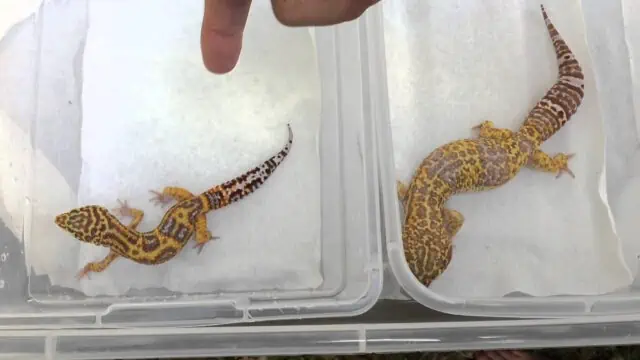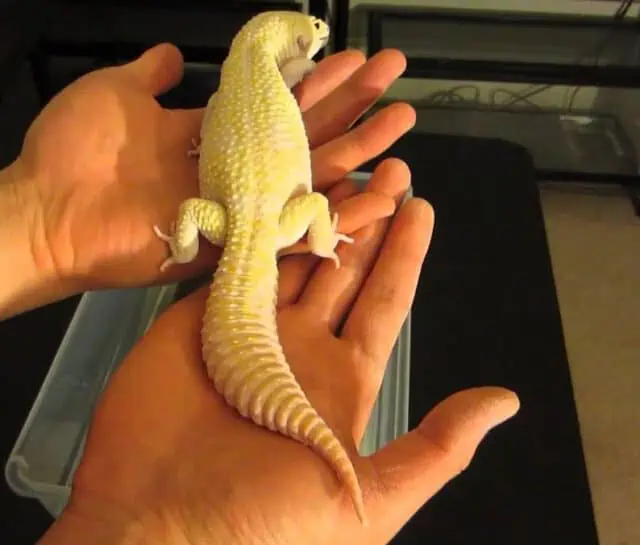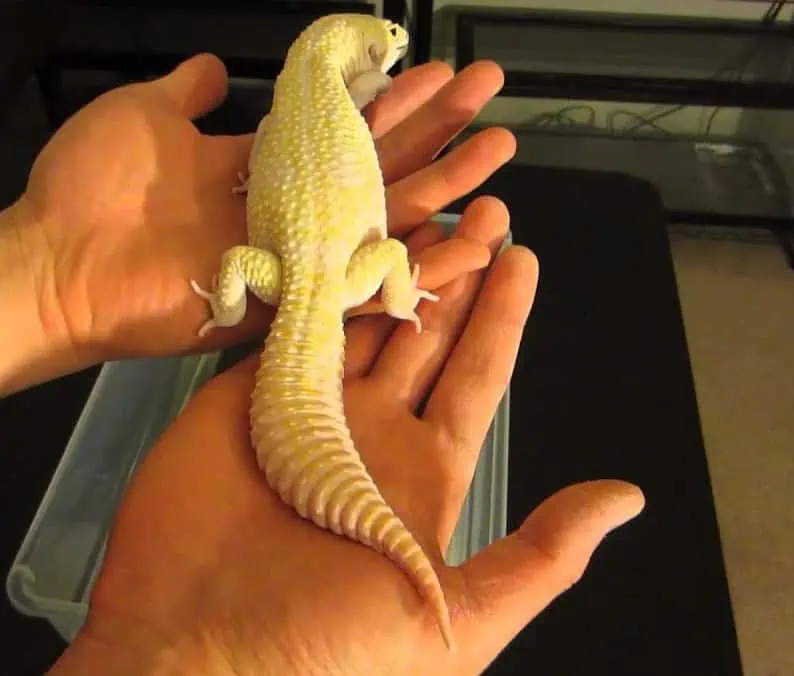The Giant Leopard Gecko morph stands as a captivating variant in the reptile world, revered predominantly for its substantial size and weight, setting it distinctly apart from the standard leopard gecko.
This particular morph maintains the inherent color patterns and eye features of the common leopard gecko, but its impressive stature and unique genetic traits elevate its appeal and desirability among enthusiasts and breeders alike.
Super Giant Trait: The Super Giant Leopard Gecko stands out primarily due to its significant size and weight, without alterations to color patterns or eyes. It’s possible to breed Super Giants from a pair of Giants or Super Giants.
Variants Explained: The three primary variants are Normal, Giant, and Super Giant. While the Normal leopard gecko is the common pet choice, the Giant and Super Giant morphs, especially the latter, are considerably larger in size.
Size Matters: By the age of one, a male Giant Leopard Gecko can weigh between 80-110 grams, while the females tip the scales at 60-90 grams. Super Giant males can even reach up to 110 grams!
Care Essentials: Giant Leopard Geckos have specific care requirements, including a diet mainly of mealworms and crickets, constant access to clean water, and ensuring cage flooring is suitable and clean. Remember, the temperature should ideally be between 88-92°F for the warm side of their habitat.
Price Point: These geckos aren’t your average pets; their prices can range between $250-$450 due to their rarity.
Traits of the Super Giant Leopard Gecko

The Super Giant Leopard Gecko is renowned for a unique trait that influences solely its size and weight, while its color patterns and eye characteristics remain comparable to those of other leopard geckos.
This distinctive attribute doesn’t alter the vibrant colors or the expressive eyes that are typical of leopard geckos, ensuring that the inherent charm of these reptiles is preserved.
This exclusive trait significantly augments the appeal of the Super Giant Leopard Gecko for those interested in up-sizing other gecko varieties.
The possibility of breeding Super Giants is especially intriguing; it can be achieved through pairing either two Super Giants or a Super Giant with a Giant.
3 Variants of Giant Leopard Gecko

In the world of giant leopard geckos, three distinct variants stand out, each characterized by unique traits and features. These are the Normal, the Giant, and the Super Giant leopard geckos, each bringing a unique set of characteristics to the table, from their size and appearance to their behavior and genetic traits.
Normal
The Normal leopard gecko, a well-known and beloved variant, is characterized by its standard size, diverse color patterns, and typical behavior, making it a popular choice as an exotic reptile pet.
These normal-sized geckos are renowned for their captivating appearance, exhibiting a wide array of colors and patterns that are sure to enchant any observer.
In terms of behavior, the common leopard gecko is known for its docility and easy-going nature, attributes that contribute to its status as a favored pet gecko. It’s generally friendly, manageable, and less demanding, making it an ideal companion for both novice and experienced reptile keepers.
When compared to the Giant and Super Giant variants, the Normal leopard gecko differs primarily in size and weight. It doesn’t possess the enhanced stature and mass that characterize its larger counterparts, retaining a more conventional gecko build.
While the Normal variant may lack the imposing presence of the Giant and Super Giant, it nonetheless holds its own with its vibrant colors, intriguing patterns, and agreeable disposition.
Giant
The Giant morph is a remarkable variant of the leopard gecko, first developed by Ron Tremper in 2000. This morph is believed to possess a Co-Dominant trait, setting it apart with its unique genetic expression and notable size.
The inception of the Giant morph by Ron Tremper marked a significant milestone in leopard gecko breeding, introducing newfound possibilities and variations within the species.
The Giant morph is categorized into three distinct phases: Normal, Giant, and Super Giant. Among these, the Normal phase does not exhibit the Giant trait, retaining the standard characteristics of common leopard geckos.
Giants, on the other hand, express the Giant trait in a heterozygous form, showcasing the distinctive attributes associated with this unique morph, albeit in a milder manifestation.
Super Giant
The Super Giant leopard gecko represents one of the most awe-inspiring phases of the Giant morph, meticulously developed by Ron Tremper. This phase is distinguished as the homozygous form of the morph, which manifests in the creation of exceptionally large geckos, showcasing the extent of variation possible within leopard gecko breeding.
The Super Giant phase amplifies the inherent traits of the Giant morph, yielding geckos that are truly remarkable in size and presence. Put one next to a regular morph, such as the Blizzard, and you can tell the difference immediately.
Ron Tremper’s original Super Giant, aptly named Moose, holds the record as the largest Leopard Gecko ever documented, boasting an impressive weight of 156 grams.
How Big Does a Giant Leopard Gecko Get?
When it comes to the size and weight of Giant Leopard Geckos, there is significant variation, especially when compared to their normal-sized counterparts. A male Giant Leopard Gecko typically weighs between 80 and 110 grams, while a female tends to weigh around 60 to 90 grams by the time they reach one year of age.
Giant Leopard Gecko Care Tips
When caring for a Giant Leopard Gecko, several key considerations and meticulous attentions are crucial to ensure the health and well-being of these extraordinary reptiles. The nuances in their care primarily revolve around diet, water, habitat conditions, and environmental controls.
When it comes to diet, Giant Leopard Geckos thrive on a regimen of mealworms, crickets, and other insects, which should be the staple of their nutritional intake. Waxworms are also suitable but should be given sparingly due to their high-fat content. A balanced and varied diet is vital to meet their nutritional needs and sustain optimal health.
Water is another essential component of their care. Providing clean and fresh water at all times is non-negotiable. Hydration plays a pivotal role in maintaining their physiological functions and overall well-being.
Regarding their living conditions, selecting suitable cage flooring is crucial. Regular cleaning is mandatory to maintain a sanitary environment and to prevent the ingestion of foreign substances, which can be detrimental to their health. The substrate should be easy to clean and non-irritating to the gecko’s skin.
Temperature and lighting are other critical elements in the care of Giant Leopard Geckos. These reptiles require external heat sources to regulate their body temperature and digest their food properly.
Maintaining a gradient temperature within their enclosure enables them to choose the most comfortable spot depending on their needs. Proper lighting is also crucial, mimicking natural light cycles to support their circadian rhythms and metabolic processes.
Giant Leopard Gecko Prices
Acquiring a Giant Leopard Gecko can be somewhat of a luxury, given their scarcity and unique traits, making their prices typically higher than normal geckos. Those interested in owning one can expect to encounter an average price range of $250-$450. However, the initial purchase price is just the tip of the iceberg.
Beyond the acquisition costs, prospective owners should anticipate higher maintenance expenses and the necessity for special care. Given their distinct requirements and substantial size, creating appropriate housing arrangements is imperative, often demanding larger and more specialized enclosures to accommodate their needs and ensure their well-being.
Moreover, their dietary needs involve a regular supply of specific insects, contributing to the ongoing costs associated with owning one of these exotic reptiles. Special care, incorporating proper diet, habitat conditions, and environmental controls, is not just optional but mandatory to uphold their health and happiness.
If you enjoyed reading about Giant Leopard Geckos, another interesting and controversial morph to learn about is the Lemon Frost Leopard Gecko.





